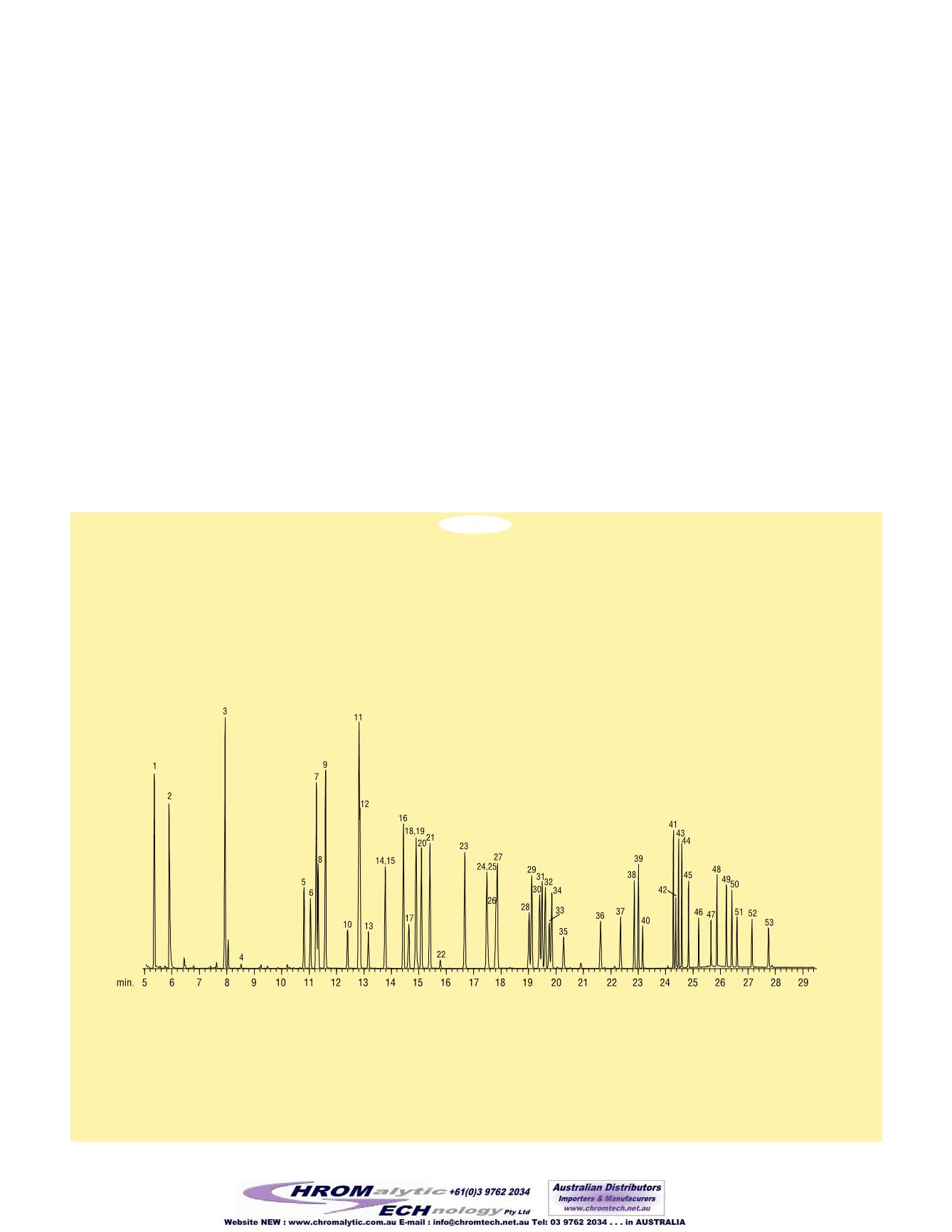

Figure 1
The Rtx
®
-OPPesticides 2 column shows excellent resolution of 53 organophosphorus pesticides.
• 14 •
www.restekcorp.comby Gary Stidsen, Innovations Manager
Analyzing Organophosphorus
Pesticides
Using an Rtx
®
-OPPesticides2 Column
and GC/MS
✔
Low column bleed improves resolution of OPPs.
✔
Fast analysis times.
✔
Allows GC/MS analysis of many OPPs.
Typically, organophosphorus pesticides (OPPs) are
analyzed using a dual-column gas chromatograph
with flame photometric detectors (FPD) or nitrogen
phosphorus detectors (NPD). These detectors pro-
vide the sensitivity needed for reporting limits, but
only for a finite number of compounds. However,
the list of compounds continues to increase, due to
the introduction of new pesticides.
As the list of compounds grows, the use of gas
chromatography/mass spectrometry (GC/MS)
becomes more desirable. GC/MS analysis requires
only one column and detector, thereby eliminating
the complexity of the dual-column GC system.
Column bleed and analyte resolution are important
factors in GC/MS analysis. Minimizing column bleed
is important to increase the signal-to-noise ratio for
GC_EV00602
1. dichlorvos
2. hexamethylphosphoramide
3. mevinphos
4. trichlorfon
5. TEPP
6. demeton-O
7. thionazin
8. tributyl phosphate (IS)
9. ethoprop
10. naled
11. sulfotepp
12. phorate
13. dicrotophos
14. demeton-S
15. monocrotophos
16. terbufos
17. dimethoate
18. dioxathion
19. fonophos
20. diazinon
21. disulfoton
22. phosphamidon isomer
23. dichlorofenthion
24. chlorpyrifos methyl
25. phosphamidon
26. parathion-methyl
27. ronnel
28. fenitrothion
29. aspon
30. malathion
31. chlorpyrifos
32. trichloronate
33. parathion-ethyl
34. fenthion
35. merphos
36. chlorfenvinphos
37. crotoxyphos
38. stirofos
39. tokuthion
40. merphos oxon
(breakdown product)
41. ethion
42. fensulfothion
43 bolstar
44. carbophenothion
45. famphur
46. triphenyl phosphate (SS)
47. EPN
48. phosmet
49. leptophos
50. tri-
o
-cresyl phosphate
51. azinphos-methyl
52. azinphos-ethyl
53. coumaphos
Column:
Rtx
®
-OPPesticides2 30m, 0.25mm ID, 0.25µm (cat.# 11243)
Sample:
Custom Mix, plus:
8140/8141 OP Pesticides Calibration Mix A (cat.# 32277)
8141 OP Pesticides Calibration Mix B (cat.# 32278)
Triphenylphosphate Standard (cat.# 32281)
Tributylphosphate Standard (cat.# 32280)
1µL, 100ppm each (100ng on column)
Inj.:
1.0µL splitless (hold 0.4 min.), 4mm double
gooseneck inlet liner (cat.# 20785)
Inj. temp.:
250°C
Carrier gas:
helium, constant flow
Flow rate:
1.0mL/min.
Oven temp.:
80°C (hold 0.5 min.) to 140°C @ 20°C/min.
to 210°C @ 4°C/min. (hold 1 min.) to
280°C @ 30°C (hold 5 min).
Det:
MS
Transfer line temp.:
280°C
Scan range:
35-400amu
Ionization:
EI
the late-eluting compounds at the detection limits.
Although the MS can spectrally resolve the sample
components, fewer coelutions in the chromatogram
make data processing easier, including confirma-
tion by spectral identification.
Using sophisticated computer-assisted stationary
phase development (CASPD) software, Restek
chemists designed the Rtx
®
-OPPesticides2 column
to provide low bleed and improve resolution for
OPP analysis by MS (Figure 1). Not only are the
separations dramatically improved compared to tra-
ditional columns for this analysis, but also the
analysis time can be reduced by almost 50%.
The combination of an Rtx
®
-OPPesticides2 GC col-
umn with MS is an excellent system for analyzing
long lists of OPPs. The column exhibits very low
bleed and excellent resolution for these com-
pounds.


















